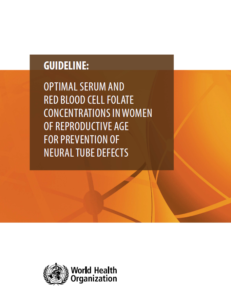
Overview
“This guideline provides global, evidence-informed recommendations on blood folate concentrations in women of reproductive age for the prevention of neural tube defects in populations.
It aims to help Member States and their partners in their efforts to make informed decisions on the appropriate nutrition actions to take to achieve the Millennium Development Goals (MDGs), in particular reduction of child mortality (MDG 4) and improvement of maternal health (MDG 5), through the establishment of appropriate threshold values for red blood cell folate concentrations at the population level. These values may be used to determine the need for, and guide monitoring and evaluation of the impact of, nutrition interventions aimed at improving folate status and preventing congenital anomalies.
In order to establish the utility of serum and red blood cell folate as biomarkers of the risk of having a pregnancy affected by neural tube defects, at population level, this guideline examined 4 critical questions:
- In the absence of an intervention, what are the key genetic, biological and sociodemographic determinants of folate status (serum, plasma or red blood cell folate) in women of reproductive age?
- What is the threshold concentration of blood folate associated with the lowest probability/risk (depending on the statistical method) of having a pregnancy affected by neural tube defects?
- Do blood folate concentrations respond to interventions to improve folate status in women?
- Does the performance of the laboratory assays used to measure folate concentrations affect serum and red blood cell folate readings?
This document presents the key recommendations and a summary of the supporting evidence.”